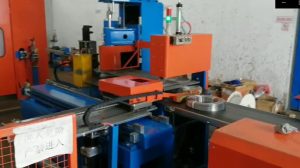Understanding the Automatic Wire Coil Winding and Strapping Machine for Efficient Packaging
Efficiently managing and packaging wire and cable coils is a critical step in many industrial processes, impacting storage, transportation, and end-use. Manual or semi-automated methods can be time-consuming, labor-intensive, and prone to inconsistencies. An Automatic Wire Coil Winding and Strapping Machine offers a comprehensive solution, streamlining these operations for enhanced productivity and product quality.
What is an Automatic Wire Coil Winding and Strapping Machine?
This integrated industrial system is designed to automate two primary processes sequentially:
- Winding: Precisely coiling wire or cable to specified dimensions (inner diameter, outer diameter, width).
- Strapping: Securely applying straps around the finished coil to maintain its shape and integrity.
By combining these functions into a single, automated workflow, these machines minimize manual handling, reduce cycle times, and ensure consistent packaging results.
Key Operational Processes Explained
How the Winding Process Works

The machine typically feeds wire from a source (like a payoff or extruder line). A winding head, often servo-driven for precision, forms the wire into a coil. Crucially, precise tension control is maintained throughout the winding process. This prevents damage such as stretching, kinking, or surface abrasions, ensuring the wire's electrical and mechanical properties remain intact. The system forms coils of consistent size and density according to pre-set parameters.
The Automated Strapping Stage
Once the desired coil size is achieved, the wire is cut, and the completed coil is transferred automatically to the strapping station. Here, one or more straps (typically durable steel or composite material) are applied around the coil's circumference. The strapping unit tensions the strap appropriately, seals it (often via welding or crimping), and cuts the excess strap material. This automated strapping ensures the coil remains tightly bound and stable for subsequent handling, storage, or shipment.
Core Features and Operational Benefits
Investing in an automatic wire coil winding and strapping machine offers several advantages:
- Fully Automated Operation: Reduces the need for manual labor, lowers operational costs, and significantly increases production throughput compared to manual methods.
- Precision Winding & Tension Control: Guarantees uniform coil dimensions and protects wire integrity, leading to higher product quality and reduced scrap rates.
- Adjustable Coil Parameters: Offers flexibility to handle various wire diameters and produce coils with different inner/outer diameters and widths, catering to diverse customer requirements.
- Robust and Secure Strapping: Ensures coils are tightly bundled using materials like steel or strong composite straps, preventing unraveling and maintaining stability during logistics.
- Integrated Control System: Advanced PLC (Programmable Logic Controller) with HMI (Human-Machine Interface) allows for easy operation, parameter adjustments, diagnostics, and recipe management for different products.
- Enhanced Safety: Incorporates safety features like sensors, guarding, and emergency stops to protect operators and the equipment.
- Durable Industrial Design: Built to withstand demanding production environments, ensuring long service life and reliable performance with minimal maintenance needs.
Typical Technical Specifications Overview
Note: The following parameters represent typical specifications for this type of equipment. Actual machine capabilities can vary significantly based on the specific model, manufacturer, and configuration. Always consult the manufacturer's documentation for exact details pertaining to a particular machine.
- Automation Level: Fully Automated Winding and Strapping Sequence
- Applicable Wire Diameter Range: Typically varies, e.g., 0.1mm to 10mm (or higher for specific applications)
- Coil Inner Diameter (ID): Adjustable, common ranges include 100mm to 500mm+
- Coil Outer Diameter (OD): Dependent on ID and wire capacity, adjustable
- Coil Width: Adjustable within machine limits
- Strapping Material: Steel strapping or Composite (e.g., PET) strapping
- Strapping Material Dimensions: Varies based on material (e.g., width 12-19mm, thickness 0.5mm-1.2mm)
- Production Speed: Highly variable, can range up to 20+ coils per minute depending on coil size and wire type
- Power Requirements: Typically industrial voltages (e.g., 480V, 60Hz, 3-phase or local equivalent)
- Control System: PLC with Touchscreen HMI
- Safety Compliance: Built to relevant industrial safety standards (e.g., CE, UL if applicable)
- Approximate Machine Footprint: Varies greatly (e.g., Length: 8000mm; Width: 3000mm; Height: 2000mm)
- Operator Input: Generally requires one operator for oversight, loading/unloading (if not fully integrated into a line), and parameter setting.
Common Industrial Applications
The efficiency and consistency offered by automatic wire coil winding and strapping machines make them valuable in numerous sectors:
Wire and Cable Manufacturing

This is a primary application area. These machines handle the final packaging stage for various wire types (building wire, communication cable, power cable), ensuring coils are ready for distribution.
Electrical Component Production
Manufacturers of smaller electrical components, including some types of harnesses or windings, utilize these systems for efficient packaging and handling before assembly or sale.
Construction Industry
While large cable reels are common, coiled wire (e.g., tie wire, smaller gauge electrical wire) is also used extensively. Automated coiling and strapping improve handling efficiency on job sites.
Shipping, Logistics, and Distribution
For companies distributing large volumes of wire, especially internationally, the secure and uniform packaging provided by these machines is crucial. It minimizes transit damage, simplifies warehouse handling (stacking, palletizing), and reduces customer complaints related to damaged or tangled products.
Enhancing Efficiency and Quality in Wire Packaging
Automatic wire coil winding and strapping machines represent a significant technological step forward in wire and cable handling. By integrating precision winding with secure, automated strapping, these systems deliver substantial improvements in:
- Operational Efficiency: Faster cycle times, reduced labor.
- Product Consistency: Uniform coil dimensions and secure packaging.
- Material Protection: Minimized risk of wire damage during processing and handling.
- Workplace Safety: Reduced manual handling risks.
These benefits contribute directly to lower operational costs, higher product quality, and improved logistics, making such automation a valuable asset in modern manufacturing and distribution environments.